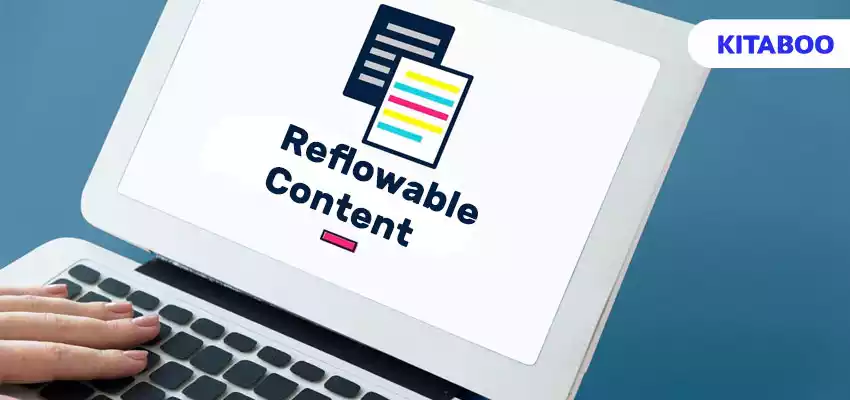
From PDF to Liquid Gold: Crafting Reflowable Content
Summarize this blog with your favorite AI:
In the realm of digital content, the transformation from physical to dynamic eBooks has been a crucial aspect of providing an engaging reader experience. While e-reading platforms have simplified publishing, creating impeccable, reflowable content remains a key step in ensuring the success of your eBook.
Generating reflowable content from a PDF may appear daunting, but it’s far from rocket science. With the help of digital textbook platforms like KITABOO, you can easily transition from PDF to reflowable content format. The platform not only simplifies the process but also empowers you to create polished, engaging, reflowable content effortlessly.
Table of Contents:
II. Step-by-Step Guide to Crafting the Perfect Reflowable Content
- Select the Right eBook Creation Software
- Start Conversions
- Focus on Strategic Placement of Images
- Add a Cover Photo
- Preview Your File
- Distribute Your eBook
III. Conclusion
Types of eBook Layouts
Below are the two major types of eBook layouts:
Reflowable layout
The basic characteristic of this type of layout is that it automatically adjusts itself to the size of the screen. This makes it easier to view on multiple devices, such as your smartphone, tablet, eReader, laptop, etc.
This type of layout can work in both landscape and portrait orientations. Books and novels are usually set in a reflowable format.
Explore: Digital Publishing Platform for Associations and Societies
Fixed layout
As the name suggests, this is a type of layout where the contents remain fixed and do not change according to the screen. This layout doesn’t have a responsive design, and the content remains static. If your content is too big for your screen, then you will have to zoom and read.
This layout is used by books such as cookbooks and recipe books, which have a higher level of image content. The reason for this is that while text can flow from one page to another, it is not possible with images.
When images are stretched, the pixels become unclear, and the images get distorted. This is why it is advisable to use the fixed EPUB format for eBooks, which have a higher load of images.
In this regard, note that KITABOO is a unique digital platform that helps publishers with the creation, publication, and distribution of eBooks in the EPUB format.
Step-by-Step Guide to Crafting the Perfect Reflowable Content
Below is a snapshot of a step-by-step guide to crafting the perfect reflowable content:
1. Select the Right eBook Creation Software
The first step to crafting perfect reflowable content is finding an eBook creation platform to get you started. There are many software options available on the web for you to choose from to convert to ePub. These tools not only simplify the process but also offer various features to enhance your reflowable content.
Among these software choices is KITABOO, a comprehensive platform that not only enables you to compose your eBook from the ground up but also seamlessly manages the intricacies of publishing and distribution.
2. Start Conversions
Once you import your file into the software, you can begin the process of converting from PDF to reflowable content format. The software will take care of everything, such as line spacing, margins, and other text formatting. It also creates a table of contents for you based on the titles.
You can also add internal and external hyperlinks, which will make the document accessible and also lead to external sites if needed.
3. Focus on Strategic Placement of Images
We do realize that the addition of images to reflowable content is a bit tricky as the text formatting changes with the screen size, but you can still incorporate images into your content by placing them in the right spot. You can place them a bit far from your written content so that the format doesn’t interfere with the image.
4. Add a Cover Photo
When your content is ready, the last step would be to put a cover photo with the leitmotif of your content in your eBook. You can take the help of external AI tools to create a cover image or create one yourself. This will make sure that your eBook not only has engaging content but also an attractive visual appeal.
5. Preview Your File
Once you are done with the last step, ensure to have an extra copy of your file in case the existing one gets corrupted. Preview the entire file for any mistakes in formatting before publishing.
After previewing and making alterations, your file is ready to be published. When you export your file, you will be given the option to give it a fixed or reflowable layout; choose the reflowable option, and you are done.
6. Distribute Your eBook
Your eBook is now ready for distribution. You can add a DRM feature to add security to your file if you want, so that it can only be accessed with the help of codes. You can hit the publish button, and now your eBook is ready to be viewed by readers.
In this context, KITABOO, as a digital textbook platform, can help publishers secure their eBooks with Digital Rights Management (DRM) features, adding an extra layer of protection to their content. This way, you can ensure that your carefully crafted reflowable content is not only engaging but also safeguarded against unauthorized use or distribution.
Conclusion
When it comes to creating engaging PDF to reflowable content format, understanding the transition from static to dynamic eBooks is essential.
This step-by-step guide explores the process, highlighting key considerations for creating an engaging reading experience. Keeping the above-mentioned points in mind, you can easily create your compelling eBook in a reflowable layout for the world to see.
If you aren’t sure where to start, KITABOO can help. It not only simplifies the conversion process but also provides tools and features that streamline the creation, publication, and distribution of reflowable content.
Write to us at contact@kitaboo.com to learn more!
Discover how a mobile-first training platform can help your organization.
KITABOO is a cloud-based platform to create, deliver & track mobile-first interactive training content.



